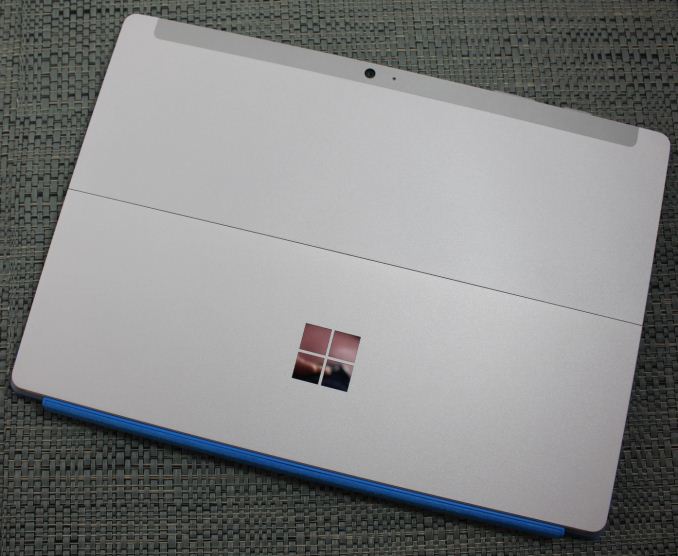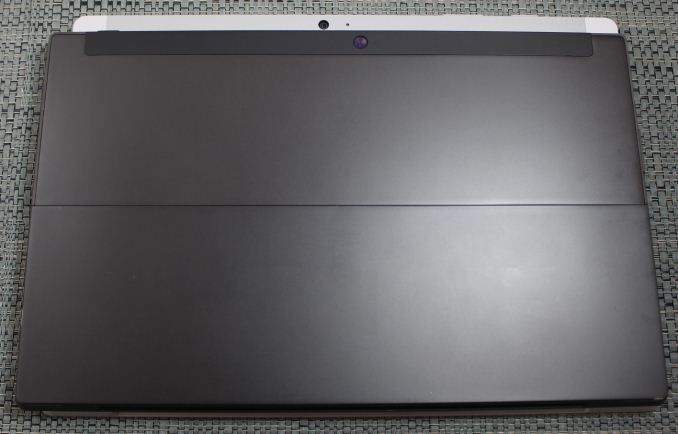The Surface 3 Review
by Brett Howse on May 4, 2015 9:00 AM EST
The Surface lineup for Microsoft has been extremely interesting to watch. What first launched in October 2012 as the Surface RT has been constantly iterated upon, and of course the Surface Pro line has evolved even faster. Surface Pro 3 has finally provided Microsoft with something that critics and consumers alike seem to have bought in to, and sales have been very strong since the Pro 3 was launched on May 20th 2014. However there has always been questions about the “consumer” version of Surface. Surface RT was, frankly, a sales disaster. The much improved Surface 2 fixed many of its shortcomings, but certainly did not set the world on fire. So now we have the third generation Surface, aptly named the Surface 3. There are a pile of changes that Microsoft has made to this generation of device, and obviously their hopes are that Surface 3 will be as popular as the Surface Pro 3 has been, but extending the device back down to a lower price point.
That price point is important. As much as the Surface Pro 3 has gained its share of fans, it is far from cheap. The most inexpensive model starts at $799, and for that you still do not get the keyboard. Surface 3 moves that bar down significantly, and the starting price is the exact same as the original Surface RT, at $499. Microsoft had to trim down the Pro model to hit this price point, but the cuts were well placed.
 Surface RT compared to Surface 3
Surface RT compared to Surface 3
I think looking at the Surface 3 in a vacuum would be improper, since the device now is really an evolution of the previous two Surface models. From a build quality standpoint, the original Surface RT was top notch, with its VaporMg case, the revolutionary kickstand, and high attention to detail for all of the aspects from buttons to display. I think in 2015 it is pretty obvious what the shortcomings of the Surface RT were though. Performance was less than acceptable with the Tegra 3 SoC on board, and Surface RT was handicapped with the confusingly named Windows RT operating system and the lack of software compatibility that goes with using an ARM CPU instead of traditional x86. Surface 2 fixed the performance issue by moving to NVIDIA’s Tegra 4 SoC, and while not the outright fastest tablet chip, it was at least in the ballpark. However it kept the Windows RT operating system at a time when everyone else had abandoned it.
Surface 3 has fixed that final issue and at the same time made some amazing improvements to the overall design and feel. Full x86 Windows is on tap, for better or for worse, and powered by a brand new SoC. This must be a special moment in history where a Microsoft built device is the launch vehicle for a brand new product from Intel. The Surface 3 is powered by the 14nm Intel Atom x7, in this case the x7-Z8700 model which is the current top of the line Atom processor. Codenamed Cherry Trail, this is the massaged Bay Trail cores now built on Intel’s now mature 14nm FinFET process, and they include the same GPU cores as Broadwell.
| Microsoft Surface Comparison | |||
| Surface 3 (Base) | Surface 3 (High) | Surface 2 | |
| Size | 10.52 x 7.36 x 0.34 inch 267 x 187 x 8.7 mm |
10.81 x 6.79 x 0.35 inch 275 x 173 x 8.8 mm |
|
| Weight | 1.37 lbs - 622 g | 1.49 lbs - 675 g | |
| Display | 10.8-inch ClearType Full HD Plus 1920x1280 resolution, 3:2 ratio 10-point multi-touch Surface Pen Support |
10.6-inch ClearType Full HD 1920 x 1080 resolution, 16:9 ratio 5-point multi-touch |
|
| Battery | 28 Wh, 13 W AC Adapter | 31.5 Wh, 24 W AC Adapter | |
| Storage | 64GB | 128GB | 32GB or 64GB eMMC |
| RAM | 2GB | 4GB | 2GB |
| CPU | Atom x7-Z8700 Quad Core 14nm 1.6 GHz Base Frequency 2.4 GHz Burst Frequency |
NVIDIA Tegra 4 4x ARM Cortex-A15 @1.7GHz |
|
| WiFi | Marvell 802.11ac + BT 4.0 LTE Models at a later date |
802.11n + BT 4.0 | |
| Ports | USB 3.0, Mini-DisplayPort, microSD, Micro USB charging, 3.5mm Headset Jack |
USB 3.0, micro-HDMI, microSD, proprietary charging | |
| Software | Windows 8.1 Office 365 Personal with 1TB OneDrive (1-year) |
Windows RT 8.1 Office 2013 RT Home & Student Edition |
|
| Front Camera | 3.5 MP | 3.5 MP | |
| Rear Camera | 8.0 MP with Autofocus | 5.0 MP | |
| Operating System | Windows 8.1 64-bit | Windows RT 8.1 | |
| Warranty | 1-year limited | 1-year limited | |
| Price | $499 | $599 | $449 |
In addition to the new SoC, Surface 3 can be purchased with up to 128 GB of eMMC storage, and the higher storage models also come with 4 GB of RAM. This compares to the base model which is 2 GB of RAM and 64 GB of storage, which is already one of the big improvements Microsoft has made with Surface. 32 GB of storage on a Windows tablet is really the bare minimum required, and the move to 64 GB as the base is going to make this tablet far more usable. You can of course add more storage with a micro SD card, but until Windows gets the great SD card support from Windows Phone, it still means that you need to manage your storage more than you should have to.
There are so many changes with the Surface 3 that really, this is likely the Surface that most people wanted from day one, but did not know it. First up is the new (again) kickstand.










265 Comments
View All Comments
meacupla - Tuesday, May 5, 2015 - link
Proprietary connectors only suck when they are easy to break and hard to replace.That said, micro USB connectors also suck on these devices, because they're also easy to break and hard to replace.
The magnetic reverseable connector on previous surface devices was perfectly fine. They were hard to break and easy to replace. Basically, the side that broke most often was either the cable or brick, which is much cheaper to fix or replace compared to the device itself.
ddawg609 - Monday, May 4, 2015 - link
Will it upgrade to Windows10 when it is released?BlueBomberTurbo - Monday, May 4, 2015 - link
Yup, everything that uses Windows 7 through 8.1 can be upgraded to Windows 10 for free for the first year of release.mva5580 - Monday, May 4, 2015 - link
As it seems with most devices these days, my main concern is with battery life.What I really want it to be is an iPad replacement that also happens to be a full PC. I'm fine with the price point (an 128gb iPad Air 2 without a case/keyboard is $700,) I'm fine with the performance (I will play games on it, but stuff that it can handle. SimCity 3000, Baldurs Gate, Out of the Park Baseball, stuff like that,) and the form factor is small enough to feel like a tablet but big enough to be able to do most "full" PC things on it.
It just seems like whenever I look at devices anymore, I'm disappointed in the battery life. So I guess either my expectations are too high, device makers don't care as much about battery life and skimp on it, or maybe a little of both. If this thing could manage the battery life of an iPad Air 2, it would dare I say, be about as "perfect" of a device as I could find for what I want to do with it. For many years to come at least when things this size can run newer, more advanced games.
I have the bundle pre-ordered from Costco that is the 4gb/128gb/Pen/Keyboard combo for $700, and I'm very much looking forward to trying it out. If the battery life isn't a disappointment, I imagine I will love it.
jjj - Monday, May 4, 2015 - link
This is a bulky and very heavy (622 g) mid range tablet and they want 500$ for it.Plus 129 $ for crappy keyboard.And it runs Windows, M$ will never get tablet apps going before tabs are dead. A crippled tablet and a crippled netbook merged into something nobody needs. Some might think they need it but that's only because they don't know any better and you are not helping them.
How hard you try to sugarcoat the pref is also rather hilarious. In GPU you go as far as flooding the reader with synthetic benchmarks (decades of PC benchmarking improvements down the drain) just to hide the single gaming perf numbers at the end.
I thought that after Anand left , the site is regaining some of it's lost objectivity but i guess you are still full steam ahead when it comes to "supporting" certain industry players.
Who payed for that trip to M$'s event last week?
mva5580 - Monday, May 4, 2015 - link
Yes, and you don't sound biased in any way whatsoever. "Bulky and very heavy" in comparison to what, exactly.You're choosing to classify it as a "tablet," can you give an example of a tablet with a similar form factor that is smaller, lighter, and cheaper that runs full Windows?
jjj - Tuesday, May 5, 2015 - link
Bulky and very heavy in compared to the vast majority of tablets. Do the math if you want for screen area per volume.How exactly is running Windows on 64GB of NAND and 2GB of RAM an advantage? If you are gonna just do Office and web browsing then you certainly don't need Windows. If yo want more, then you need more than this.As for the AR, it doesn't matter much and it's actually M$ trying to copy Apple and going just slightly different to not be called a clone. Pricing wise you can do 2x better.
damianrobertjones - Wednesday, May 6, 2015 - link
Ummm... Windows Tablets have been around for a long, long, LONG time. Archos 9, UMPCs, Mids, plus many, many more types.Geodude074 - Saturday, May 9, 2015 - link
Asus T100 Chi vs Surface 3- $450 for tablet/keyboard combo vs $630 for tablet/keyboard combo.
- 1.3 lbs vs 1.4 lbs.
- 1920x1080 vs 1920 x 1280.
- Same 2 GB RAM.
- Same 64 GB storage.
- Same full Windows.
- Z3775 vs Z8700 (the only advantage Surface 3 has).
Is it worth spending ~$200+ for the Atom x7? In my opinion, no not really.
devione - Monday, May 4, 2015 - link
Jesus Christ. I stopped reading at "bulky and heavy".If you find 622g bulky and heavy, you really need to get your life sorted out.